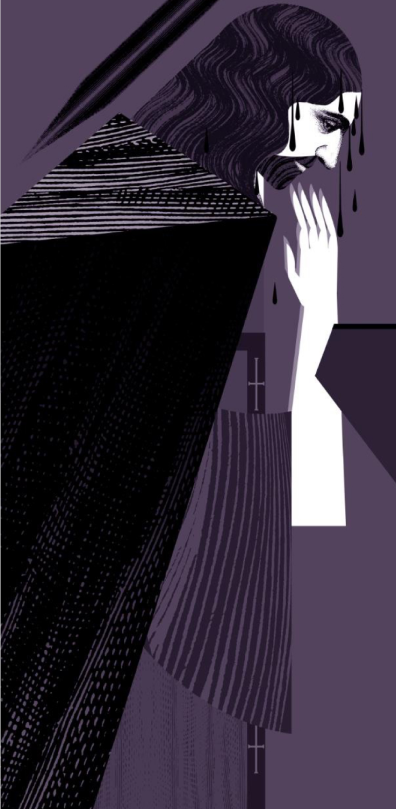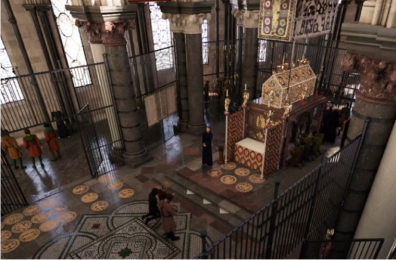A Walk Through Time activity sheets
Click here to find a programme of curriculum linked classroom activities and resources to support the ‘A walk through time’ resource.
Download activity sheetsOn 29 December 1170, Archbishop Thomas Becket was confronted at the Cathedral by four knights. Becket had argued with King Henry II over the division of power between the King and the Church and had excommunicated some of Henry’s followers. The knights demanded that Becket pardon these men and when he refused to do so, one of the knights sliced off the top of Becket’s head with a sword. Soon after his death local people began to report miracles associated with items which were covered in Becket’s blood. Becket became a saint and his tomb at the Cathedral became a pilgrimage site.
Thomas Becket was an educated and clever man. Before becoming Archbishop, he had been King Henry II’s Chancellor and great friend. Thomas was persuaded by the King to become the Archbishop of Canterbury in 1162, the King no doubt hoping that by appointing his friend and ally to this role he would be able to hold more influence and control over the Church. However, once given this new role, Archbishop Thomas Becket took his new job very seriously indeed. He became a holy and dedicated priest who fought the King’s attempts to rule the Church.

The Church held enormous power in medieval England. King Henry II thought that churchmen who broke the law should not be tried in church courts but handed over to the King’s court. He hoped, as Archbishop, Becket would help him make this law, but Becket refused.
We do not know if Henry meant for his knights to kill Becket. Whilst celebrating Christmas in France he is alleged to have cried out in anger and frustration, ‘Will no one rid me of this turbulent priest?’ But we do not know if he ever said this, or what he might have meant by it.
After Becket was made a saint, Henry undertook a pilgrimage of forgiveness as penance (to ask forgiveness for committing a sin) for his murder. Henry walked barefoot through the streets of Canterbury wearing a poor sackcloth rather than his royal robes. Reaching Becket’s tomb he was beaten by monks and he spent the night with no food or blanket on the Cathedral floor.
‘Finally, shown through a vision that there was no other way of obtaining peace except placating and reconciling the martyr, in whose revenge such great confusion of things now seized the whole realm, so that without much blood no one might hope for peace, the king put aside his pride for a time and with a contrite and humble heart je came to the tomb of the precious martyr to beg pardon for his presumption. While he was hastening there, and was already near the town, so that he might make clear with how much love he was devoted to the saint of God, with how much penitence he was moved on account of what he had done to him, he advanced through the town, in bare feet and ordinary clothes, weeping as he walked, wherever the road appeared roughest, from the church of our blessed father Dunstan, which is the first one meets on entering Canterbury. To the great church where the body of the blessed of the blessed martyr rests. He did not think of the harshness of the path, the tenderness of his feet, or the spectacle to the common people all about, but only the danger to his soul and the scar on his conscience…Coming then to the door of the church he fell prostrate and prayed, but when he went in his drenched the place of martyrdom with tears and kisses. He said confession before the bishops present, and with much trembling and reverence he approached the tomb. Then he prostrated his entire body, and intent on prayer in an extraordinary way what sobs he emitted, what sighs, with what a copious shower of tears he flooded the marble, cannot be estimated..Before Christ the Lord… our lord king recalls that the venerable archbishop was killed by evil men neither on his ordr nor with his knowledge… But because of the words that anger brought forth, which it is believed gave an occasion for profane harshness to carry out the killing, and because he harassed the archbishop during his life so unyieldingly. He proclaims himself blameworthy and begs forgiveness, and is prepared to give satisfaction in every way according to your judgement. Therefore he begs the influential support of your community, so that his abject penance may be acceptable in the sight of the Lord our Saviour… he restores in full the privileges and rights of this church… but also… he offers £30 as a gift to the martyr, so that with your intercession he may be well disposed and forgetful of injuries. Besides, he abandons all ill-feeling in his heart to all those who seemed to have offended him in the cause of the venerable archbishop… After this he removed his outer clothes, and leaned his head and shoulders into one of the openings of the tomb with every humble devotion, so much so that it provoked everyone to tears, and he was whipped five times by the bishops, and three times more by each of the eighty monks, and thus was solemnly absolved. That done, he remained on the bare ground, with the mud not even washed from his bare feet, fasting as he had come, for sorrow and penitence did not allow him any break. He spent the whole night in prayer… ’William of Canterbury – Edward Grim, MTB 2.445
The miracles attributed to Saint Thomas were recorded by two monks, William and Benedict, shortly after his murder. Monks often wrote about the lives of saints to celebrate a holy person’s life and the things they did. They were meant to provide an example for normal people to follow. These stories also told people the miracles that had occurred both in the Saint’s life and after their death and they helped to establish the place they were buried as an important site for pilgrims.
A fire in 1174 and the subsequent rebuilding of the Cathedral allowed for the creation of a new shrine in the Trinity Chapel. Many pilgrims visited hoping for miracle cures to blindness, epilepsy and leprosy. Saint Thomas became the most popular saint in Late Medieval Britain. The medieval author Geoffrey Chaucer based his famous book The Canterbury Tales on a group of pilgrims who were visiting Saint Thomas’ shrine.
Becket was a controversial figure even at the time of his death. Many people thought he was a brave and strong Archbishop standing up for the rights of the church against the king. Others felt that even given his position as Archbishop of Canterbury and therefore the head of the church in England, he should still have obeyed the king. He was undoubtedly not popular with those he had excommunicated (told they could not be part of the church).

However, it is said that immediately after he died, as the monks prepared his body for burial they discovered seven layers of clothing on Thomas’ body. Under his fine Archbishop’s robes he wore the simple clothing of a poor monk and next to his skin was a hair shirt, crawling with lice. The monks believed that he wore this horribly itchy garment all the time on purpose as an act of humility, to show he was sorry for all the things that he did wrong.
Discover more about Chaucer and The Canterbury TalesThe place where Becket was murdered. The Altar of the Sword Point marks the place where the tip of the sword which killed Saint Thomas was kept on an altar in the middle ages.
Pilgrims to Saint Thomas’ Shrine would have come up the Pilgrim steps on their knees as an act of respect. The shrine was originally located in the Trinity Chapel.
Part of Becket’s head was placed here after he was murdered. Corona means ‘crown’ and refers to the top part of the head.
This tunnel was built in about 1420 so pilgrims coming to Saint Thomas’ tomb could visit without disturbing the monks who lived there.
The East of the Crypt was the location of Becket’s tomb for the first 50 years after he died.
Click here to find a programme of curriculum linked classroom activities and resources to support the ‘A walk through time’ resource.
Download activity sheets© Dean and Chapter of Canterbury Cathedral
